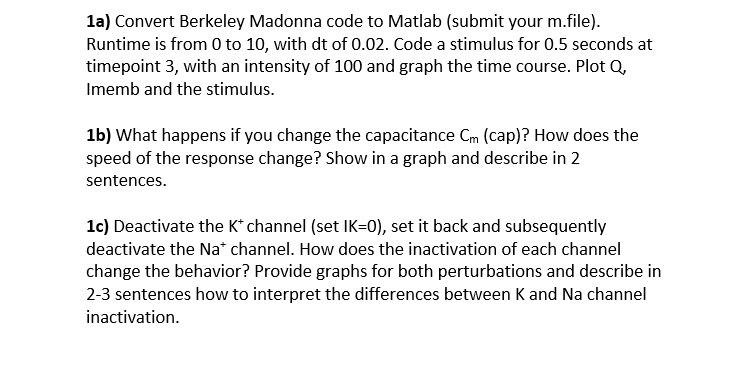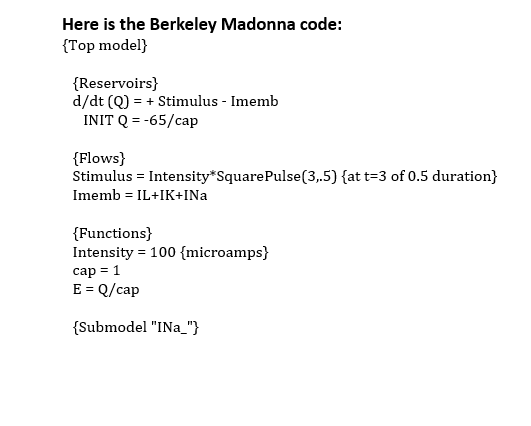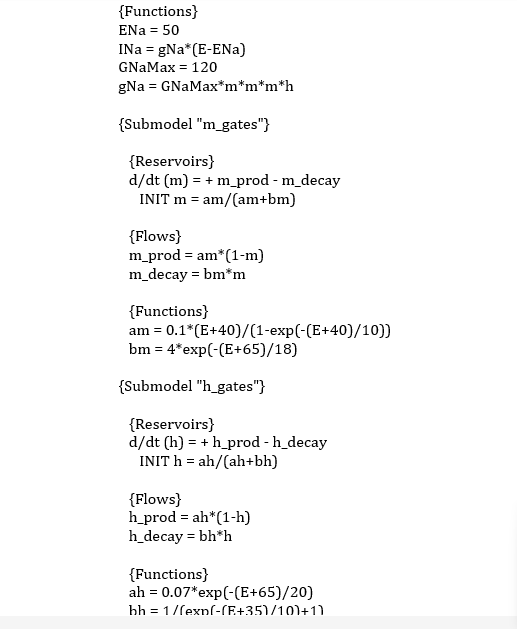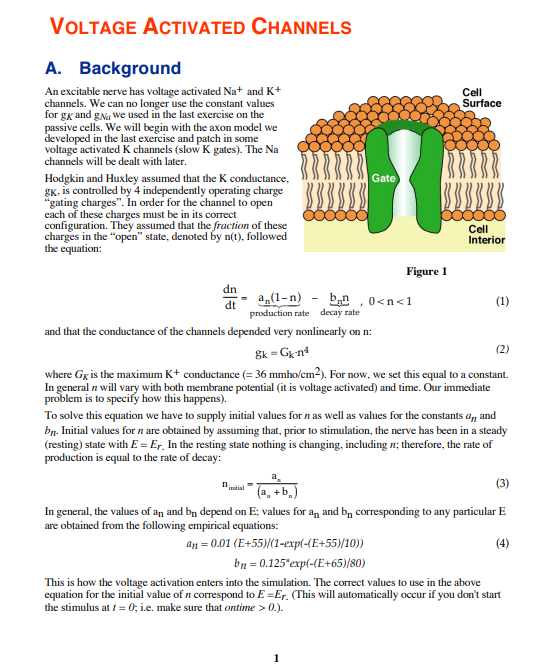Question
I need help developing the code and answering 1a- c based on the code: 1a) Convert Berkeley Madonna code to Matlab (submit your m.file). Runtime
I need help developing the code and answering 1a- c based on the code:
1a) Convert Berkeley Madonna code to Matlab (submit your m.file). Runtime is from 0 to 10, with dt of 0.02. Code a stimulus for 0.5 seconds at timepoint 3, with an intensity of 100 and graph the time course. Plot Q, Imemb and the stimulus.
1b) What happens if you change the capacitance Cm (cap)? How does the speed of the response change? Show in a graph and describe in 2 sentences.
1c) Deactivate the K+ channel (set IK=0), set it back and subsequently deactivate the Na+ channel. How does the inactivation of each channel change the behavior? Provide graphs for both perturbations and describe in 2-3 sentences how to interpret the differences between K and Na channel inactivation.
Here is the Berkeley Madonna code:
{Top model}
{Reservoirs}
d/dt (Q) = + Stimulus - Imemb
INIT Q = -65/cap
{Flows}
Stimulus = Intensity*SquarePulse(3,.5) {at t=3 of 0.5 duration}
Imemb = IL+IK+INa
{Functions}
Intensity = 100 {microamps}
cap = 1
E = Q/cap
{Submodel "INa_"}
{Functions}
ENa = 50
INa = gNa*(E-ENa)
GNaMax = 120
gNa = GNaMax*m*m*m*h
{Submodel "m_gates"}
{Reservoirs}
d/dt (m) = + m_prod - m_decay
INIT m = am/(am+bm)
{Flows}
m_prod = am*(1-m)
m_decay = bm*m
{Functions}
am = 0.1*(E+40)/(1-exp(-(E+40)/10))
bm = 4*exp(-(E+65)/18)
{Submodel "h_gates"}
{Reservoirs}
d/dt (h) = + h_prod - h_decay
INIT h = ah/(ah+bh)
{Flows}
h_prod = ah*(1-h)
h_decay = bh*h
{Functions}
ah = 0.07*exp(-(E+65)/20)
bh = 1/(exp(-(E+35)/10)+1)
{Submodel "IK_"}
{Functions}
EK = -77
IK = gK*(E-EK)
gK_max = 36
gK = gK_max*n*n*n*n
{Submodel "n_gates"}
{Reservoirs}
d/dt (n) = + n_prod - n_decay
INIT n = an/(an+bn)
{Flows}
n_prod = an*(1-n)
n_decay = bn*n
{Functions}
an = 0.01*(E+55)/(1-exp(-(E+55)/10))
bn = 0.125*exp(-(E+65)/80)
{Submodel "IL_"}
{Functions}
IL = gL*(E-EL)
EL = -54.4
gL = .3
{Globals}
{End Globals}
One way to code a square pulse in Matlab:
___________________________________________________
% % Generate Pulse between 3 and 3.5 seconds
if t>3 && t
else squarepulse = 0;
end




Background info:

Please help!! Thank you :)
1a) Convert Berkeley Madonna code to Matlab (submit your m.file). Runtime is from 0 to 10 , with dt of 0.02 . Code a stimulus for 0.5 seconds at timepoint 3, with an intensity of 100 and graph the time course. Plot Q, Imemb and the stimulus. 1b) What happens if you change the capacitance Cm (cap)? How does the speed of the response change? Show in a graph and describe in 2 sentences. 1c) Deactivate the K+channel (set IK=0 ), set it back and subsequently deactivate the Na+channel. How does the inactivation of each channel change the behavior? Provide graphs for both perturbations and describe in 2-3 sentences how to interpret the differences between K and Na channel inactivation. Here is the Berkeley Madonna code: Top model } \{Reservoirs d/dt(Q)=+ Stimulus - Imemb INIT Q=65/ cap \{Flows Stimulus = Intensity SquarePulse(3,.5) at t=3 of 0.5 duration } Imemb =IL+IK+INa \{Functions\} Intensity =100 \{microamps } cap =1 E=Q/cap \{Submodel "INa_" Voltage ACtivated Channels A. Background An excitable nerve has voltage activated Na+and K+ channels. We can no longer use the constant values passive cells. We will begin with the axon model we developed in the last exercise and patch in some voltage activated K channels (slow K gates). The Na channels will be dealt with later. Hodgkin and Huxley assumed that the K conductance, gK, is controlled by 4 independently operating charge "gating charges". In order for the channel to open each of these charges must be in its correct configuration. They assumed that the fraction of these charges in the "open" state, denoted by n(t), followed the equation: Figure 1 dtdn=productionratean(1n)decayratebnn,0
Step by Step Solution
There are 3 Steps involved in it
Step: 1

Get Instant Access to Expert-Tailored Solutions
See step-by-step solutions with expert insights and AI powered tools for academic success
Step: 2

Step: 3

Ace Your Homework with AI
Get the answers you need in no time with our AI-driven, step-by-step assistance
Get Started


